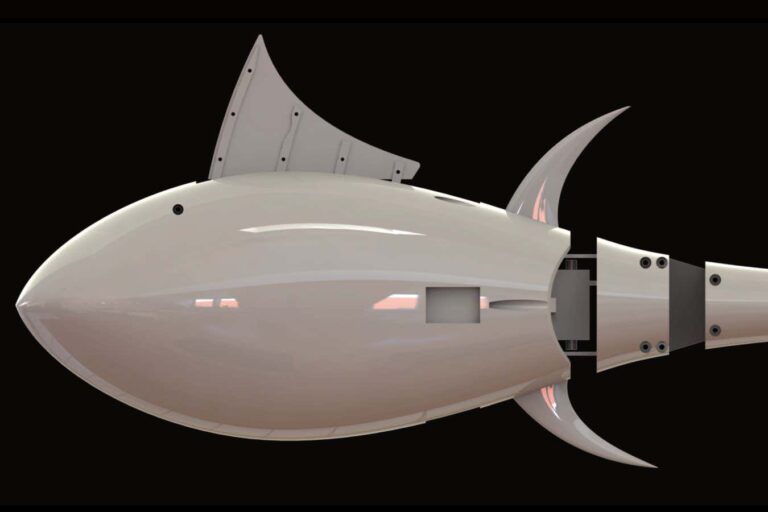Robo-tuna reveals how foldable fins help the speedy fishuvre
Introduction:
The incredible and speed of aquatic creatures have long fascinated scientists and engineers alike. One such remarkable example is the tunafish, which is known for its remarkable swimming abilities. To understand and replicate these capabilities, researchers at the University of Virginia have developed a robotic tuna, aptly named Robo-tuna. Through their study of Robo-tuna’s foldable fins, researchers have gained valuable insight into the secrets behind the fish’s extraordinary manoeuvring skills. This article will explore how the foldable fins of the tuna fish contribute to its speedy movements and highlight the potential applications this knowledge could have in various fields.
1. The anatomy and functionality of the tunafish’s fins:
The tunafish possesses an elongated body with powerful muscles and a distinctive set of pectoral fins. These pectoral fins are retractable and consist of a series of fin rays or spines supported by muscles and connective tissues. By utilizing a dedicated musculoskeletal system, the tunafish can control the positioning and angle of its fins, allowing precise adjustments to its swimming behavior.
2. Hydrodynamic advantages of foldable fins:
A key advantage of the tunafish’s foldable fins lies in their hydrodynamic properties. The ability to retract, expand, and adjust the position of the fins in response to varying flow conditions helps minimize drag and allows the fish to maintain higher speeds without expending excessive energy. By manipulating the fin shape and surface area, tunafish can optimize their cruising efficiency and maneuverability.
3. Controlling fin flexion and extension:
Robo-tuna has been instrumental in studying the complex mechanisms involved in controlling fin flexion and extension. By replicating the tunafish’s fin structure and incorporating artificial muscles, researchers have been successful in mimicking the kinematics of the fish’s fins. Understanding the dynamics of fin flexion and extension has enabled a deeper comprehension of the tunafish’s exceptional maneuvering capabilities.
4. Achieving efficient propulsion through fin-fold adjustments:
Robo-tuna’s foldable fins have shed light on another significant aspect of the tunafish’s swimming prowess: its ability to generate efficient propulsion. The tunafish expertly adjusts the angle of its horizontal fins during propulsion, using them as a vortex generator. This controlled movement creates high-pressure zones, propelling the fish forward while minimizing energy wastage. Such insights into propulsion mechanisms can potentially revolutionize the design of underwater vehicles and enhance their efficiency and speed.
5. Optimal fin folding for turns and changes in direction:
The tunafish’s flexible fins are not only advantageous for maintaining constant speed but also for swift and precise turns. By retracting one fin and expanding the other asymmetrically, the fish generates localized velocity differences along the body, facilitating sharp changes in heading. Robo-tuna’s ability to mimic this behavior has demonstrated that similar techniques could be applied to the development of maneuverable robotic vehicles or even enhance the agility of existing submarines.
6. Biomimetic applications and beyond:
The knowledge gained from Robo-tuna’s foldable fins extends beyond pure scientific curiosity; it offers immense potential for practical applications. By implementing bio-inspired foldable fins, engineers could enhance the performance of underwater vehicles, manned or unmanned, enabling increased maneuverability and reduced energy consumption. Additionally, advancements in foldable fin technology could revolutionize the design of propulsion systems in marine vehicles, industrial applications, and even recreational watercraft.
7. Conclusion:
The study of Robo-tuna’s foldable fins has provided valuable insights into the remarkable agility and maneuverability of the tunafish. By understanding the intricate mechanisms behind the tunafish’s control over its fins, scientists and engineers have opened doors to new possibilities in biomimetic designs and underwater propulsion systems. It is through these discoveries that we continue to uncover nature’s secrets and apply them to create innovative solutions in various fields, bringing us closer to unlocking the full potential of aquatic locomotion.
Robo-tuna reveals how foldable fins help the speedy fish manoeuvre
Robo-tuna reveals how foldable fins help the speedy fishuvreIntroduction:The incredible and speed of aquatic creatures have long fascinated scientists and engineers alike. One such remarkable example is the tunafish, which is known for its remarkable …
